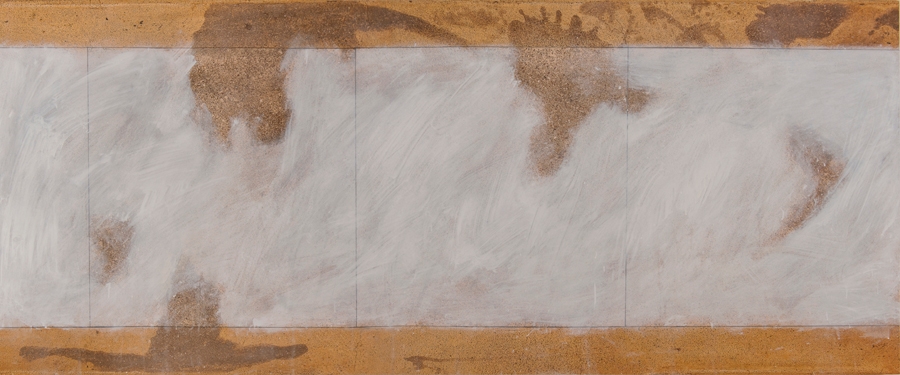Looming sadly through a maelstrom of paint in Carlos Zilio’s Tamanduá, os continentes e o cosmos (2013–14), a shadowy black figure stares into the distance, its curved bill suggesting a rook, a crow or, following the cues offered by its almost cartoonish form, maybe even a penguin.
The brooding figure, repeated in all the paintings in this exhibition, is none of those things: it is, as the name of this painting (Anteater, the continents and the cosmos) and all the other paintings state, an anteater. The subject of dozens of paintings by the Rio de Janeiro-based artist since the 1980s, the animal is for Zilio a Proustian figure, representing for him a kind of hereditary saudade – a Portuguese word meaning ‘longing’, ‘nostalgia’. So the story goes, the animal was a pet belonging to Zilio’s father as a child during the 1920s, which met a sudden death when it tumbled down the staircase of the family home.
Earlier works have shown an anteater in freefall, sailing over a staircase or sloping dangerously down the canvas; but in these paintings the animal is portrayed upright, poised and, so many years after the fall, perhaps even resurrected. This new series was inspired by a stain on the granite floor in the hallway leading to Zilio’s studio, which once he had noticed it, had the unmistakable form of the animal, paired with a second shape spied on the same floor – for Zilio, according to the titles of these works, a continent, or a lost continent.
In many of the works, forms mass behind the animal figure in a pulsing, whirling vortex of paint reminiscent of 1980s and 90s works by Zilio, where thick paint and lavishly textured brushstrokes told wordless, eloquent stories – daubs of green rushing this way and that in Matisse’s Garden (1984); glowing, evocatively sunny yellows in Leonardo Goes to the Beach (1999).
In Tamanduá e os continentes (2013–14), the painted mass is to the fore as a flat wash of acrylic over the anteater / floorstain, like a white mist shrouding the omnipresent animal, which shines through regardless, in light, glowing peach. Strong saudade, the mythical nature of family legends and the recherche du temps perdu converge in the shape of this insistent family pet; yet the revisiting of such a distant tragedy, over and over, seems more curious than ever in the light of Zilio’s own history, which has all the drama of a thriller.
Zilio trained with the expressionist painter Iberê Camargo during the 1960s, in an early career that took o¡ around the same time as that of Brazil’s military dictatorship. Showing conceptual, political art such as Luta (Struggle, 1967), an aluminium lunchbox containing a yellow masklike face, its mouth obscured by a screenprinted word, ‘lute’ – the imperative of the verb ‘to struggle’ – Zilio took part in a number of important exhibitions, including Opinião 66 (1966), A Nova Objetividade Brasileira (1967) and the ninth São Paulo Bienal (1967).
In 1968, Zilio abandoned art to immerse himself in politics, joining the revolutionary guerrilla group MR-8 and dedicating himself to the armed struggle. Severely wounded in a shootout in 1969, he was arrested and spent the next two-and-a-half years in prison, later going into exile in France in 1976. In the catalogue text accompanying these paintings, the curator Ronaldo Brito invokes Gerhard Richter’s October 18, 1977 (1988), 15 hazy paintings based on news images of the Baader-Meinhof gang, including some of the members lying dead in their cells. There’s reminiscence in the black-and-white palette, and a hint, perhaps, in Zilio’s dark Tamanduá e os continentes, of Richter’s meticulous obfuscation in Arrest 2. For a fleeting moment, Zilio’s hook-billed form suddenly looks like a rifle, a machine gun; but the real similarity between the works, in the end, is the in the inchoate, dreamlike shadows that haunt both series of paintings, and in the mysterious ways of memory, simultaneously concealing and revealing the anteater, its fall and the fallout from long-ago political passion.
This article was first published in the January & February 2015 issue.
